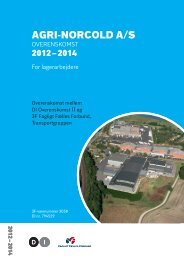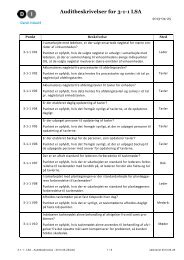Hydrogen and its competitors, 2004
Hydrogen and its competitors, 2004
Hydrogen and its competitors, 2004
Create successful ePaper yourself
Turn your PDF publications into a flip-book with our unique Google optimized e-Paper software.
26Risø Energy Report 3Technologies for producing hydrogen5.1CO 2 (optional)Figure 5: Flowsheet of a typical reforming unit.Tubular reformerPrereformerWaste heat channelFeed from HDSProcess steamreduce soot formation. This method is mostly used forheavy feeds. Some soot is formed <strong>and</strong> is removed in aseparate scrubber system downstream of the partialoxidation reactor [3]. As with other thermal methods,this process typically produces a gas containinghydrogen <strong>and</strong> CO in the ratio 1.7-1.8:1. Downstream COremoval is therefore needed to produce pure hydrogen.The auto-thermal reforming (ATR) process [4] is a hybridof partial oxidation <strong>and</strong> steam reforming, using a burner<strong>and</strong> a fixed catalyst bed to allow the gas to reach equilibrium.ATR is the preferred technology for the large-scaleproduction of synthesis gas for methanol or syntheticdiesel plants based on Fisher-Tropsch synthesis. Forhydrogen plants, ATR using oxygen is only economic atvery large scales because of the capital cost of the oxygenplant.In catalytic partial oxidation (CPO) the reactants arepremixed, <strong>and</strong> all the chemical conversions take place ina catalytic reactor without a burner [5,6]. The direct CPOreaction (Table 6) yields a hydrogen/CO molar ratio of 2<strong>and</strong> has a low heat of reaction (38 kJ/mol). In practice,the reaction is accompanied by the reforming <strong>and</strong> watergas shift reactions, <strong>and</strong> at high conversions the productgas will be close to thermodynamic equilibrium [2]. COremoval is necessary to produce pure hydrogen.Table 7: Comparison of CPO <strong>and</strong> steam reforming for producing hydrogento supply low-temperature fuel cells [10].CPOCompactHigher combined(heat + power) efficiencyNo steam addedShort start-up timeFewer heat exchangersAutothermalSteam reformingHigher electrical efficiencyHigher cell voltageNo noble metal catalystHigher hydrogen yield atreformer outletNo need for air compressionFor automotive applications [7,8], the choice of hydrogengeneration technology for small fuel cells (5-50 kW)is dictated by criteria such as simplicity of design <strong>and</strong>rapid response to transients (Table 7). Steam reforming islikely to be the most energy-efficient process for theseapplications, but catalytic partial oxidation or autothermalreforming with air may be preferred because theequipment is more compact [9].<strong>Hydrogen</strong> from biomass <strong>and</strong> microorganismsGeneral aspectsBiomass <strong>and</strong> biomass-derived fuels are renewable energysources that can be used to produce hydrogen sustainably.Using biomass instead of fossil fuels to producehydrogen reduces the net amount of carbon dioxidereleased to the atmosphere, since the carbon dioxidereleased when the biomass is gasified was previouslyabsorbed from the atmosphere <strong>and</strong> fixed by photosynthesisin the growing plants.Most regions of the world have enough suitable biomass– agricultural crops, crop residues, wood, agro-industrialwaste, household waste, animal manure, sewage sludge<strong>and</strong> so on – to provide significant economic <strong>and</strong> environmentalbenef<strong>its</strong>. The eventual aim should be to coproducehydrogen alongside other value-added by-products.A wide range of technologies exists for transformingbiomass into hydrogen (Figure 6). The conversion maytake place either directly or via storable intermediates.Processes can be grouped into thermochemical <strong>and</strong>biological (fermentation) routes, both of which are relevantin the near- <strong>and</strong> mid-term. In the long term it mayalso be possible to produce hydrogen using photobiologicalprocesses, such as photosynthesis in cyanobacteria<strong>and</strong> algae.<strong>Hydrogen</strong> or hydrogen-rich gas derived from biomasscan readily be used in most hydrogen energy conversiondevices <strong>and</strong> fuel cells. However, no technology forproducing hydrogen from biomass or microbes is yet
















